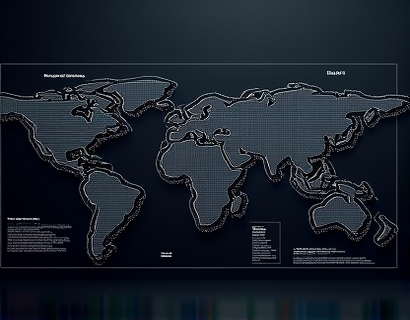Maximizing Multi-Chain Token Management: A Complete Guide for Blockchain Optimization and Performance
In the rapidly evolving world of blockchain technology, managing tokens across multiple chains effectively is crucial for maximizing performance and ensuring seamless operations. This guide aims to provide blockchain professionals and token managers with essential tools and strategies to optimize token management across diverse blockchains. From creation to tracking and optimization, this comprehensive resource will equip you with the knowledge needed to enhance your token's efficiency and performance in the dynamic crypto landscape.
Understanding Multi-Chain Token Management
Multi-chain token management involves overseeing tokens that operate on different blockchain networks. Each blockchain has its unique characteristics, consensus mechanisms, and smart contract frameworks, which can impact token functionality and performance. Understanding these differences is the first step in effective multi-chain token management. Token managers must be aware of the specific requirements and limitations of each blockchain to design tokens that leverage the strengths of each network.
Key Considerations for Multi-Chain Tokens
- Blockchain Compatibility: Ensure the token design is adaptable to various blockchain environments, considering factors like gas fees, transaction speed, and smart contract capabilities.
- Interoperability: Implement solutions that allow tokens to seamlessly move between different blockchains, enhancing liquidity and accessibility.
- Security: Prioritize robust security measures to protect tokens from vulnerabilities specific to each blockchain.
- User Experience: Design intuitive interfaces and processes to facilitate user interaction across multiple chains.
By addressing these considerations, token managers can create tokens that not only function well on individual blockchains but also offer a cohesive experience across multiple networks.
Creating Multi-Chain Tokens
The creation process for multi-chain tokens involves several critical steps. First, define the token's purpose and functionality. Determine whether the token will serve as a utility token, security token, or a combination of both. This definition will guide the technical implementation and regulatory compliance.
Next, choose the appropriate blockchain(s) for token deployment. Ethereum remains a popular choice due to its mature ecosystem and extensive developer community, but other blockchains like Binance Smart Chain, Solana, and Polkadot offer compelling alternatives with lower fees and faster transaction times. Consider the target audience and the specific advantages each blockchain provides.
Smart contract development is a pivotal part of creating multi-chain tokens. Utilize programming languages like Solidity for Ethereum or Plutus for Polkadot to write secure and efficient smart contracts. Implement features such as token transfer, staking, and voting, ensuring they are optimized for the chosen blockchains. Conduct thorough testing to identify and fix any bugs or vulnerabilities before deployment.
Cross-Chain Bridges and Atomic Swaps
To enable seamless token movement between blockchains, leverage cross-chain bridges and atomic swaps. Cross-chain bridges facilitate the transfer of tokens from one blockchain to another, while atomic swaps allow for direct token exchanges without intermediaries. These technologies enhance liquidity and user convenience, but they also introduce complexity and potential security risks. Carefully select and integrate reliable bridge and atomic swap solutions to ensure smooth multi-chain operations.
Tracking Multi-Chain Tokens
Effective tracking of multi-chain tokens is essential for monitoring performance, managing supply, and ensuring compliance. Implement comprehensive tracking systems that can monitor token movements across different blockchains in real-time. Utilize blockchain analytics tools to gather data on token transactions, ownership, and market activity.
Integrate these tools with your token management platform to provide a unified view of token performance across all deployed chains. This integrated approach allows token managers to quickly identify trends, address issues, and make data-driven decisions. Regularly review and update tracking mechanisms to adapt to changes in the blockchain landscape.
Data Visualization and Reporting
Data visualization plays a crucial role in understanding complex multi-chain token data. Use charts, graphs, and dashboards to present key metrics such as token supply, transaction volume, and user engagement. These visual tools help token managers and stakeholders grasp the overall performance and health of the token across different blockchains.
Generate detailed reports that summarize token activities, highlight areas for improvement, and provide insights for strategic planning. Automate report generation to save time and ensure consistent, accurate reporting. Share these reports with team members, investors, and regulatory bodies as needed.
Optimizing Multi-Chain Token Performance
Optimizing token performance across multiple blockchains involves continuous monitoring and adjustment. Here are some strategies to enhance token efficiency and user experience:
- Gas Optimization: Minimize gas costs on Ethereum by optimizing smart contract code and utilizing layer 2 solutions like Optimism or Polygon. For other blockchains, choose those with cost-effective transaction models.
- Scalability Solutions: Implement scalability solutions such as sharding, sidechains, or rollups to handle high transaction volumes and reduce latency.
- User Engagement: Foster a strong community around the token to increase adoption and usage. Engage users through social media, forums, and incentives.
- Interoperability Enhancements: Continuously improve cross-chain interoperability to facilitate smoother token transfers and broader accessibility.
- Security Audits: Regularly conduct security audits to identify and mitigate vulnerabilities, ensuring the token remains secure across all deployed blockchains.
By focusing on these optimization strategies, token managers can enhance the overall performance and reliability of their multi-chain tokens, providing a superior experience for users and stakeholders.
Regulatory Compliance and Risk Management
Navigating the regulatory landscape is a critical aspect of multi-chain token management. Different blockchains and jurisdictions have varying regulations regarding tokens, especially security tokens. Stay informed about local and international regulations and ensure compliance to avoid legal issues.
Implement robust risk management practices to mitigate potential threats. This includes conducting thorough due diligence on partners and service providers, maintaining transparent communication with stakeholders, and establishing clear governance structures. Regularly review and update compliance measures to adapt to changing regulatory environments.
Disclosure and Transparency
Transparency is key to building trust with users and regulators. Provide clear and comprehensive disclosures about the token's functionality, distribution, and governance. Use blockchain's inherent transparency to your advantage by making token data and operations openly accessible. This openness can help alleviate concerns and foster a positive reputation.
Regularly update stakeholders on token performance, upcoming developments, and any changes in the regulatory landscape. Open lines of communication can help manage expectations and maintain a positive relationship with the community.
Future Trends in Multi-Chain Token Management
The landscape of multi-chain token management is continually evolving, driven by technological advancements and changing market demands. Stay ahead by keeping abreast of emerging trends and innovations:
- Cross-Chain Protocols: New cross-chain protocols are being developed to improve interoperability and reduce costs. Stay informed about these developments and consider integrating them into your token management strategy.
- Decentralized Finance (DeFi) Integration: As DeFi continues to grow, integrating multi-chain tokens with DeFi platforms can unlock new opportunities for users and enhance token utility.
- Sustainability and Green Blockchain: There is a growing focus on environmentally friendly blockchain solutions. Explore eco-friendly blockchains and sustainable practices to align with global sustainability goals.
- Regulatory Clarity: As regulations evolve, seek to understand and adapt to new guidelines that may impact multi-chain token operations. Engage with regulatory bodies to influence positive changes.
By embracing these trends, token managers can position their tokens for long-term success and resilience in the dynamic blockchain ecosystem.
In conclusion, maximizing multi-chain token performance requires a comprehensive approach that covers creation, tracking, optimization, and compliance. By leveraging the right tools and strategies, blockchain professionals and token managers can ensure their tokens thrive in the multi-chain environment, delivering value and efficiency to users and stakeholders alike.










































